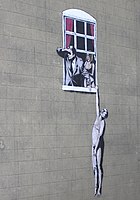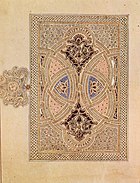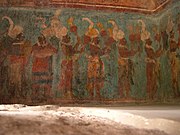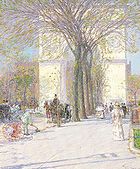Painting Pop Art, Contemporary Painting, Painting of Islam, African Painting and American Painting
Painting Pop Art

Aucassiu and Nicolette of Charles Demuth (1921) Precision metal work
Born in the 1950s in England, the Pop Art will mainly develop in America with artists such as Jasper Johns, Larry Rivers and Robert Rauschenberg in the 1960s although, from the years 1920-1930, the paintings of Gerald Murphy, Stuart Davis and Charles Demuth founder of the movement Precision metal, already marked the advent of Pop Art. It should be noted that in the early 1950s, most artists who subsequently enrolled in the Pop Art movement, made a painting described as abstract expressionism. It will really until the early 60s to the Pop Art movement take off. Among the most renowned artists of this art movement, it must include Andy Warhol, Claes Oldenburg, Wayne Thiebaud, James Rosenquist, Jim Dine, Tom Wesselmann and Roy Lichtenstein among others.
What characterizes the Pop Art is its willingness to merge popular culture of mass art with the more refined, with a dose of humor, irony and figurative language perfectly recognizable. Lawrence Alloway, the inventor the term "Pop Art" and pointed to the paintings that celebrated consumerism of the postwar period, that is to say a movement that rejected abstract expressionism focuses on the hermeneutic and psychological, for an art celebrating the culture, advertising, and iconography of the era of mass consumption.
New abstract painting.
The movement Color Field, which is a continuation of Suprematism and the lyrical abstraction, became the United States in the 1950s. It marked a clear new direction in American painting, away from the abstract expressionism, seeking to rid art of rhetoric as superfluous.
Thus, artists like Clyfford Still, Mark Rothko, Hans Hofmann, Morris Louis, Jules Olitski and Kenneth Noland portrayed little nature, especially painting based on a psychological use of color. In general, these artists have eliminated recognizable forms.
One of the trends of movement Colorfield painting is the use of canvas not rectangular, the so-called shaped canvas. This was the case with artist such as Frank Stella, Kenneth Noland, Ellsworth Kelly, Barnett Newman, Ronald Davis, Neil Williams, Robert Mangold, Charles Hinman, Richard Tuttle and David Novros the early 60s. This trend marked a reaction against the mysticism and the hyper-subjectivity of the abstract expressionism and against the entrenched idea that the use of a rectangular canvas is the classic sign of a painting called "serious".
The 1960s saw the birth of another movement, the lyrical abstraction, a term European who has been reused by Larry Aldrich in 1969. The lyrical abstraction, as the movement Fluxus, trying to push the boundaries of abstract painting and Minimalism by focusing on the creative process, new materials and new forms of expression. This form of painting often incorporates industrial materials, raw materials and various objects with references to Dada and Surrealism.
There are similarities between firstly the lyrical abstraction and, secondly, the Color Field and the abstract expressionism especially in the very free use of colors, textures and surfaces. But the two styles are markedly different. In the abstract expressionist painting or the action painting of the years 1940-1950, the emphasis is on composition and sense of drama, theatrical sense of the term. In contrast, the lyrical abstraction there is a sense of composition very random and discreet and made a priority in the process of creation, rehearsal and sensitivity.
During the 1960s and 1970s, many influential artists have adopted these styles of painting, including Robert Motherwell, Philip Guston, Cy Twombly, Josef Albers, Agnes Martin, Helen Frankenthaler, Gene Davis, Joan Mitchell or even younger painters like Robert Mangold, Ronnie Landfield or Susan Crile.
During the years 1960-1970, there was a reaction against abstract painting. Critics have not hesitated to speak of "death of painting" citing for example the work of a painter like Ad Reinhardt. The artists then gradually practiced a new way of making art and new movements in painting | movements have emerged as postminimalism the Land Art, the Art video, the installation, the Arte Povera, l 'performance art, the body art, the Fluxus, the mail art, the situationism or "conceptual art.
Neo-expressionism, Figuration Libre

Time measurement Gianfredo Camesi
In the late 70s and early 80s, several movements emerged almost simultaneously in Italy, Germany, France and Great Britain. These very similar movements took different names: Neo-Expressionism or Heftige Germany, Trans-avant-garde in Italy, Bad Painting in the United States and Figuration Libre in France.
This style of painting is characterized by large size, great freedom of expression, figuration, the reference to myth and imagination. Art critics were divided over these movements, some of them as being dictated by the interests of large commercial art galleries. This style of painting continues to be popular in the XXI century.
Contemporary Painting of XXI century

The Naked Man of Banksy

Saint-Paul-de-Vence Lucas Suppin
In the early twenty-first century, the painting and the contemporary art continued to grow through various movements that are characterized by the ideas of pluralism and globalization.
The "crisis" of painting in the 1980s now tends to be resolved through pluralism. There is no consensus on a representative style of contemporary painting. Works of art are still beautiful and important to emerge in a variety of styles such as the geometric abstraction, the hyper-realism, the photorealism, the expressionism, the minimalism, the lyrical abstraction, the pop art, the Op art, the abstract expressionism, the Color Field, the Neo-Expressionism, the bonding, the digital painting, the painting postmodern, the shaped canvas, the mural, the Global Style, the Global Realism
Painting of Islam

Painting on paper Yahya ibn Mahmud al-Wasit, Iraq (1237)

Ornament on the Quran
The Islam forbids representation of human beings, animals and all the items on the believers to avoid the idolatry which explains that in principle there is no religious painting (or sculpture) in Muslim culture. Long visual art has therefore limited the arabesques, often abstract, with geometrical configuration or floral. Usually related to the architecture and calligraphy, painting Islam is reflected in the painting tiles in mosques or in illuminations of the Koran and other books.
In fact, the abstract art is not an invention of the modern art, but it was present in cultures pre-classical and non-Western many centuries before and was essentially a decorative art. Art Nouveau, with Aubrey Beardsley and the architect Antonio Gaudi, has reintroduced abstract floral patterns into western art.
However, despite the taboo of figurative representation, few Muslim countries have cultivated a rich pictorial tradition, not in the form of tables, but rather as a means to illustrate messages. Thus the Iranian or Persian art, mostly known through the Persian miniature, concentrates on the illustration of epic or romantic events in the literature. Persian illustrators deliberately avoided the use of shadow and light or the perspective to observe the rule of not creating an illusion of reality too realistic. Their goal was not to portray the world as it is, but to represent images of an ideal world of timeless beauty and perfect order.
African Painting
Culture and traditional African tribes seem to have a great interest in two-dimensional representations and emphasize the sculpture and bas-reliefs. Decorative painting in the African culture is often abstract and geometric. Another form of visual representation is the body paint found for example in culture Maasai and Kikuyu in their ceremonial rituals.

Importantly, Pablo Picasso and other modern artists were influenced by sculpture and African masks. The contemporary African artists are frequently in the movements of Western painting.
American Painting

Frescoes of Structure 1 at Bonampak.
The earliest American paintings are found in Mexico. Under the colonial era, Western influences began to have an impact on American art. These include Miguel Cabrera (1695 - 1768), Mexican painter of the Viceroyalty of New Spain, a few years later the Mexican José María Velasco (1840 to 1912). The mural of Mexico has developed in the twentieth century.
The painting of the United States and Canada has been influenced by the Western world. Examples include Asher Durand American landscape painter of the Hudson River School in the mid-nineteenth century, Antoine-Sébastien Falardeau Canadian painter. Childe Hassam (1859 - 1935) was a painter impressionist major U.S.. Abstract Expressionism is a movement that s' was developed shortly after the Second World War, the movement was born in New York around 1945. expressionism U.S., the American Scene, the Minimalism and Bad Painting are artistic movement emerged in the twentieth SIEC.
Today, American painting continues to develop its own style.

Miguel Cabrera, Sor Juana.

Sanford Gifford, Morning on the Hudson, 1866, Art Institute of Chicago

Childe Hassam Washington Arch Spring.
Like it on Facebook, Tweet it or share this article on other bookmarking websites.


